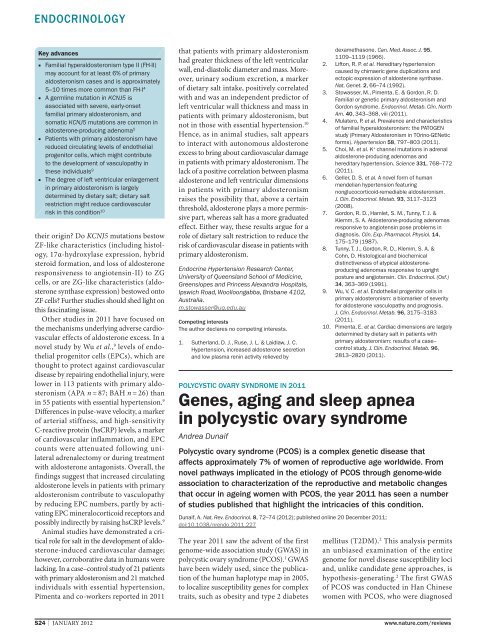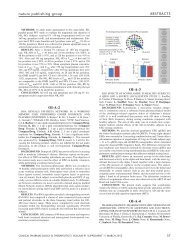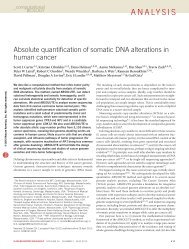open access: Nature Reviews: Key Advances in Medicine
open access: Nature Reviews: Key Advances in Medicine
open access: Nature Reviews: Key Advances in Medicine
Create successful ePaper yourself
Turn your PDF publications into a flip-book with our unique Google optimized e-Paper software.
ENDOCRINOLOGY<br />
<strong>Key</strong> advances<br />
■ Familial hyperaldosteronism type II (FH-II)<br />
may account for at least 6% of primary<br />
aldosteronism cases and is approximately<br />
5–10 times more common than FH-I 4<br />
■ A germl<strong>in</strong>e mutation <strong>in</strong> KCNJ5 is<br />
associated with severe, early-onset<br />
familial primary aldosteronism, and<br />
somatic KCNJ5 mutations are common <strong>in</strong><br />
aldosterone-produc<strong>in</strong>g adenoma 5<br />
■ Patients with primary aldosteronism have<br />
reduced circulat<strong>in</strong>g levels of endothelial<br />
progenitor cells, which might contribute<br />
to the development of vasculopathy <strong>in</strong><br />
these <strong>in</strong>dividuals 9<br />
■ The degree of left ventricular enlargement<br />
<strong>in</strong> primary aldosteronism is largely<br />
determ<strong>in</strong>ed by dietary salt; dietary salt<br />
restriction might reduce cardiovascular<br />
risk <strong>in</strong> this condition 10<br />
their orig<strong>in</strong>? Do KCNJ5 mutations bestow<br />
ZF-like characteristics (<strong>in</strong>clud<strong>in</strong>g his tology,<br />
17α-hydroxylase expression, hybrid<br />
steroid formation, and loss of aldosterone<br />
responsive ness to angiotens<strong>in</strong>-II) to ZG<br />
cells, or are ZG-like characteristics (aldosterone<br />
synthase expression) bestowed onto<br />
ZF cells? Further studies should shed light on<br />
this fasc<strong>in</strong>at<strong>in</strong>g issue.<br />
Other studies <strong>in</strong> 2011 have focused on<br />
the mechanisms underly<strong>in</strong>g adverse cardiovascular<br />
effects of aldosterone excess. In a<br />
novel study by Wu et al., 9 levels of endothelial<br />
progenitor cells (EPCs), which are<br />
thought to protect aga<strong>in</strong>st cardiovascular<br />
disease by repair<strong>in</strong>g endothelial <strong>in</strong>jury, were<br />
lower <strong>in</strong> 113 patients with primary aldosteronism<br />
(APA n = 87; BAH n = 26) than<br />
<strong>in</strong> 55 patients with essential hypertension. 9<br />
Differences <strong>in</strong> pulse-wave velocity, a marker<br />
of arterial stiffness, and high- sensitivity<br />
C-reactive prote<strong>in</strong> (hsCRP) levels, a marker<br />
of cardiovascular <strong>in</strong>flammation, and EPC<br />
counts were attenuated follow<strong>in</strong>g unilateral<br />
adrenalectomy or dur<strong>in</strong>g treatment<br />
with aldosterone antagonists. Overall, the<br />
f<strong>in</strong>d<strong>in</strong>gs suggest that <strong>in</strong>creased circulat<strong>in</strong>g<br />
aldosterone levels <strong>in</strong> patients with primary<br />
aldosteronism contribute to vasculopathy<br />
by reduc<strong>in</strong>g EPC numbers, partly by activat<strong>in</strong>g<br />
EPC m<strong>in</strong>eralocorticoid receptors and<br />
possibly <strong>in</strong>directly by rais<strong>in</strong>g hsCRP levels. 9<br />
Animal studies have demonstrated a critical<br />
role for salt <strong>in</strong> the development of aldosterone-<strong>in</strong>duced<br />
cardiovascular damage;<br />
how ever, corroborative data <strong>in</strong> humans were<br />
lack <strong>in</strong>g. In a case–control study of 21 patients<br />
with primary aldosteronism and 21 matched<br />
<strong>in</strong>dividuals with essential hyperten sion,<br />
Pimenta and co-workers reported <strong>in</strong> 2011<br />
that patients with primary aldosteronism<br />
had greater thickness of the left ventricular<br />
wall, end-diastolic dia meter and mass. Moreover,<br />
ur<strong>in</strong>ary sodium excretion, a mar ker<br />
of dietary salt <strong>in</strong>take, positively correlated<br />
with and was an <strong>in</strong>depen dent predictor of<br />
left ventricular wall thickness and mass <strong>in</strong><br />
patients with pri mary aldosteronism, but<br />
not <strong>in</strong> those with essential hypertension. 10<br />
Hence, as <strong>in</strong> animal studies, salt appears<br />
to <strong>in</strong>teract with auto nomous aldosterone<br />
excess to br<strong>in</strong>g about cardio vascular damage<br />
<strong>in</strong> patients with primary aldosteronism. The<br />
lack of a posi tive correlation between plasma<br />
aldoster one and left ventricular dimen sions<br />
<strong>in</strong> patients with primary aldosteronism<br />
raises the possibility that, above a certa<strong>in</strong><br />
thres hold, aldosterone plays a more permissive<br />
part, whereas salt has a more graduated<br />
effect. Either way, these results argue for a<br />
role of dietary salt restriction to reduce the<br />
risk of cardiovascu lar disease <strong>in</strong> patients with<br />
primary aldosteronism.<br />
Endocr<strong>in</strong>e Hypertension Research Center,<br />
University of Queensland School of Medic<strong>in</strong>e,<br />
Greenslopes and Pr<strong>in</strong>cess Alexandra Hospitals,<br />
Ipswich Road, Woolloongabba, Brisbane 4102,<br />
Australia.<br />
m.stowasser@uq.edu.au<br />
Compet<strong>in</strong>g <strong>in</strong>terests<br />
The author declares no compet<strong>in</strong>g <strong>in</strong>terests.<br />
1. Sutherland, D. J., Ruse, J. L. & Laidlaw, J. C.<br />
Hypertension, <strong>in</strong>creased aldosterone secretion<br />
and low plasma ren<strong>in</strong> activity relieved by<br />
dexamethasone. Can. Med. Assoc. J. 95,<br />
1109–1119 (1966).<br />
2. Lifton, R. P. et al. Hereditary hypertension<br />
caused by chimaeric gene duplications and<br />
ectopic expression of aldosterone synthase.<br />
Nat. Genet. 2, 66–74 (1992).<br />
3. Stowasser, M., Pimenta, E. & Gordon, R. D.<br />
Familial or genetic primary aldosteronism and<br />
Gordon syndrome. Endocr<strong>in</strong>ol. Metab. Cl<strong>in</strong>. North<br />
Am. 40, 343–368, viii (2011).<br />
4. Mulatero, P. et al. Prevalence and characteristics<br />
of familial hyperaldosteronism: the PATOGEN<br />
study (Primary Aldosteronism <strong>in</strong> TOr<strong>in</strong>o-GENetic<br />
forms). Hypertension 58, 797–803 (2011).<br />
5. Choi, M. et al. K + channel mutations <strong>in</strong> adrenal<br />
aldosterone-produc<strong>in</strong>g adenomas and<br />
hereditary hypertension. Science 331, 768–772<br />
(2011).<br />
6. Geller, D. S. et al. A novel form of human<br />
mendelian hypertension featur<strong>in</strong>g<br />
nonglucocorticoid-remediable aldosteronism.<br />
J. Cl<strong>in</strong>. Endocr<strong>in</strong>ol. Metab. 93, 3117–3123<br />
(2008).<br />
7. Gordon, R. D., Hamlet, S. M., Tunny, T. J. &<br />
Klemm, S. A. Aldosterone-produc<strong>in</strong>g adenomas<br />
responsive to angiotens<strong>in</strong> pose problems <strong>in</strong><br />
diagnosis. Cl<strong>in</strong>. Exp. Pharmacol. Physiol. 14,<br />
175–179 (1987).<br />
8. Tunny, T. J., Gordon, R. D., Klemm, S. A. &<br />
Cohn, D. Histological and biochemical<br />
dist<strong>in</strong>ctiveness of atypical aldosteroneproduc<strong>in</strong>g<br />
adenomas responsive to upright<br />
posture and angiotens<strong>in</strong>. Cl<strong>in</strong>. Endocr<strong>in</strong>ol. (Oxf.)<br />
34, 363–369 (1991).<br />
9. Wu, V. C. et al. Endothelial progenitor cells <strong>in</strong><br />
primary aldosteronism: a biomarker of severity<br />
for aldosterone vasculopathy and prognosis.<br />
J. Cl<strong>in</strong>. Endocr<strong>in</strong>ol. Metab. 96, 3175–3183<br />
(2011).<br />
10. Pimenta, E. et al. Cardiac dimensions are largely<br />
determ<strong>in</strong>ed by dietary salt <strong>in</strong> patients with<br />
primary aldosteronism: results of a case–<br />
control study. J. Cl<strong>in</strong>. Endocr<strong>in</strong>ol. Metab. 96,<br />
2813–2820 (2011).<br />
POLYCYSTIC OVARY SYNDROME IN 2011<br />
Genes, ag<strong>in</strong>g and sleep apnea<br />
<strong>in</strong> polycystic ovary syndrome<br />
Andrea Dunaif<br />
Polycystic ovary syndrome (PCOS) is a complex genetic disease that<br />
affects approximately 7% of women of reproductive age worldwide. From<br />
novel pathways implicated <strong>in</strong> the etiology of PCOS through genome-wide<br />
association to characterization of the reproductive and metabolic changes<br />
that occur <strong>in</strong> age<strong>in</strong>g women with PCOS, the year 2011 has seen a number<br />
of studies published that highlight the <strong>in</strong>tricacies of this condition.<br />
Dunaif, A. Nat. Rev. Endocr<strong>in</strong>ol. 8, 72–74 (2012); published onl<strong>in</strong>e 20 December 2011;<br />
doi:10.1038/nrendo.2011.227<br />
The year 2011 saw the advent of the first<br />
genome-wide association study (GWAS) <strong>in</strong><br />
polycystic ovary syndrome (PCOS). 1 GWAS<br />
have been widely used, s<strong>in</strong>ce the publication<br />
of the human haplotype map <strong>in</strong> 2005,<br />
to localize susceptibility genes for com plex<br />
traits, such as obesity and type 2 dia betes<br />
mellitus (T2DM). 2 This analysis per mits<br />
an unbiased exam<strong>in</strong>ation of the entire<br />
genome for novel disease susceptibility loci<br />
and, unlike candidate gene approaches, is<br />
hypothesis-generat<strong>in</strong>g. 2 The first GWAS<br />
of PCOS was conducted <strong>in</strong> Han Ch<strong>in</strong>ese<br />
women with PCOS, who were diagnosed<br />
S24 | JANUARY 2012 www.nature.com/reviews








